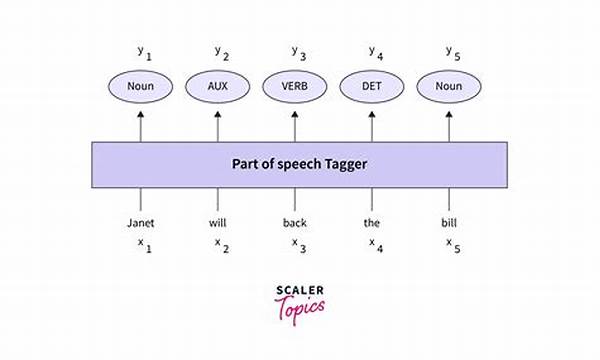Hey there, fellow language enthusiasts! Today, we’re diving into the fabulous world of part-of-speech tagging methods. If you’ve ever wondered how computers manage to understand and categorize the different parts of our sentences, you’re in for a treat! This process is pivotal in making machines comprehend human language. Let’s explore the nitty-gritty of tagging, the various methods used, and how they’re changing the way we interact with technology.
What is Part-of-Speech Tagging?
Alright, so what exactly is part-of-speech tagging? Imagine breaking down sentences into their grammatical components: nouns, verbs, adjectives, and so on. Part-of-speech tagging is the jazzy process where computers assign these tags to each word in a sentence. This helps machines understand the structure and meaning of text, a foundational step in natural language processing. The methods include rule-based approaches, where language experts create specific rules for tagging, and statistical models, which use patterns from large datasets to predict tags. There’s also the recent rise of machine learning methods, which leverage big data and algorithms to become even smarter at predicting part-of-speech tags. It’s like teaching a computer the grammar rules we learned in school, but on steroids!
Different Approaches to Part-of-Speech Tagging
1. Rule-Based Tagging: Just think of it as a classic method where experts set grammar rules, and the computer follows them meticulously.
2. Statistical Tagging: This method uses probability from big text samples, betting on what each word likely is, based on its neighbors.
3. Stochastic Tagging: Adding a sprinkle of randomness, this technique uses probabilistic models to guess the part-of-speech fun.
4. Transformation-Based Learning: It’s like the computer learns some basic rules, makes mistakes, and corrects them often until mastery.
5. Neural Network Tagging: Dive deep into the world of AI, where neural networks learn complex patterns to assign part-of-speech tags accurately.
Evolution of Part-of-Speech Tagging
Remember the good old days when everything was manual? Similarly, part-of-speech tagging methods started with manual rule-based systems. These systems were heavily reliant on linguistic experts who painstakingly crafted rules. While effective to some degree, they were limited in handling the vast and evolving nature of languages. Enter the era of machine learning. Statistical models revolutionized the field, allowing computers to analyze and learn from vast corpora to predict tags. With the advent of more sophisticated algorithms, the methods became even more robust and efficient.
In recent years, the integration of deep learning, particularly neural networks, has further advanced part-of-speech tagging methods. These models, inspired by how the human brain works, have shown remarkable accuracy and adaptability. They can process large amounts of data and identify complex patterns, enabling them to tag parts of speech with impressive precision. This evolution highlights the dynamic intersection between linguistics and technology, promising an exciting future.
The Significance of Part-of-Speech Tagging Methods
Understanding language on a computer level wouldn’t be possible without part-of-speech tagging methods. These methods provide a structured way for machines to decipher the nuances of human communication. Whether it’s analyzing a tweet, parsing a legal document, or even just correcting your grammar in a text, part-of-speech tagging plays a vital role. It essentially acts as a bridge between raw text and meaningful data.
Imagine the impact: from accurate voice assistants that understand you better to translation tools that feel almost human-like. All these advancements are rooted in the effective application and evolution of part-of-speech tagging methods. It’s an unsung hero of technology, quietly empowering countless applications we often take for granted.
Practical Applications of Part-of-Speech Tagging
The real-world applications of part-of-speech tagging methods are truly endless. Have you ever used a virtual assistant or a chatbot? These tools rely heavily on tagging methods to accurately understand your queries and provide relevant responses. In the realm of search engines, these methods help improve the accuracy and relevance of search results by understanding queries more deeply.
In the world of content creation, part-of-speech tagging methods assist in grammar checkers and writing enhancement tools. They help in identifying not just incorrect grammar but also stylistic improvements to make writing more engaging. In academic research, these methods enable the automatic summarization and categorization of vast amounts of text, making the research process more efficient. As technology continues to evolve, the possibilities for applications will only expand, making these tagging methods a fundamental component of digital interaction.
Challenges and Future of Part-of-Speech Tagging
Just like any other field, part-of-speech tagging methods face their fair share of challenges. Languages are complex and ever-evolving, making it difficult to create models that can handle all nuances and anomalies. Dialects, slang, and context-specific language use can throw even the best models for a loop. On top of that, the sheer diversity of languages worldwide poses a daunting challenge for developers.
However, the future looks promising. Researchers are constantly developing better algorithms and more efficient models to tackle these challenges. With advancements in AI and machine learning, especially with innovations like NLP transformers, part-of-speech tagging methods are set to become more accurate and versatile. The integration of human-like understanding in machines is closer than ever, made possible by these continual advancements.
Wrapping Up Our Journey
So, there you have it—our whirlwind tour through the fascinating world of part-of-speech tagging methods. From their historical roots to their cutting-edge applications today, these methods have proven indispensable in bridging human language with machine understanding. They’re not just academic; they’re practical, shaping the tools and technologies we use daily.
As our digital world grows, the importance of part-of-speech tagging will only increase, helping machines become more fluent in human language. So next time you chat with a virtual assistant or use a grammar checker, give a nod to the intricate part-of-speech tagging methods working tirelessly behind the scenes. Happy tagging!

